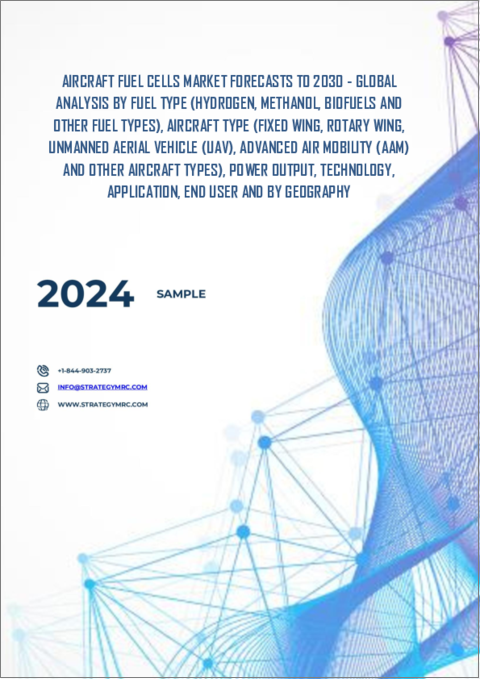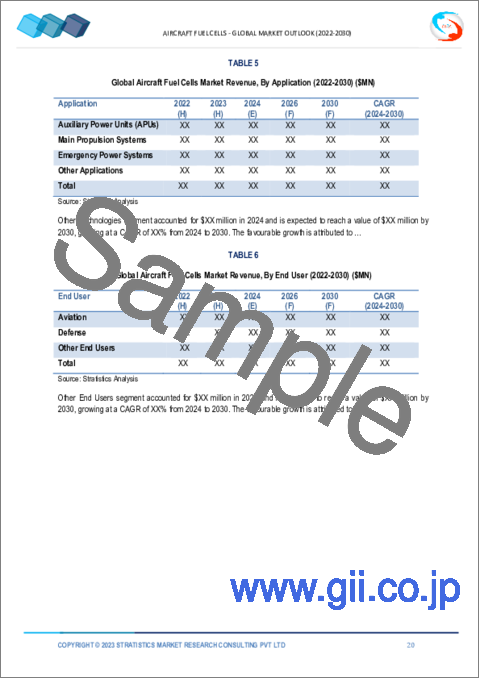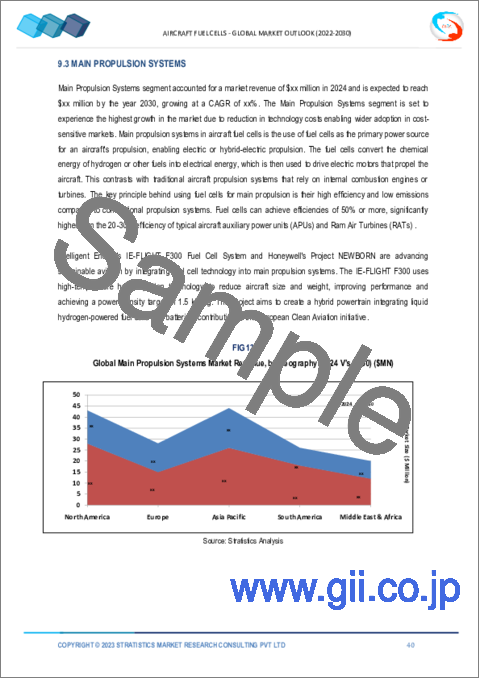|
|
市場調査レポート
商品コード
1530709
航空機用燃料電池市場の2030年までの予測: 燃料タイプ、航空機タイプ、出力、技術、用途、エンドユーザー、地域別の世界分析Aircraft Fuel Cells Market Forecasts to 2030 - Global Analysis By Fuel Type, Aircraft Type, Power Output, Technology, Application, End User and by Geography |
||||||
カスタマイズ可能
|
|||||||
| 航空機用燃料電池市場の2030年までの予測: 燃料タイプ、航空機タイプ、出力、技術、用途、エンドユーザー、地域別の世界分析 |
|
出版日: 2024年08月01日
発行: Stratistics Market Research Consulting
ページ情報: 英文 200+ Pages
納期: 2~3営業日
|
全表示
- 概要
- 図表
- 目次
Stratistics MRCによると、航空機用燃料電池の世界市場は2024年に18億米ドルを占め、予測期間中のCAGRは12.8%で成長し、2030年には37億2,000万米ドルに達する見込みです。
航空機用燃料電池として知られる高度なエネルギー変換技術は、水素と酸素の電気化学反応の製品別として水のみを生成して電気を作り出します。これらの燃料電池は、高効率で環境にも優しいため、従来の化石燃料ベースの航空推進システムの代替となります。さらに、航空機用燃料電池は二酸化炭素の排出をなくし、騒音公害も軽減するため、より環境にやさしく静かな航空セクターが実現します。
国際航空運送協会(IATA)によれば、航空業界における燃料電池技術の採用は、2050年までに炭素排出量を正味ゼロにするという業界の目標達成に向けた重要な一歩です。
環境に優しい航空機の必要性
航空業界における持続可能な慣行に対する消費者や利害関係者の意識の高まりと需要の結果として、航空会社はより環境に優しい技術を採用しつつあります。燃料電池は、航空業界がより持続可能な産業へと移行するために不可欠なものと考えられています。旅行者、特に若い世代は、環境への意識が高いため、持続可能性を優先する航空会社を選んでいます。さらに、投資家からの圧力や企業の社会的責任プログラムは、航空会社に対し、環境への影響を最小限に抑えるよう尽力していることを証明するよう圧力をかけています。
高い乗り出し価格
大きな障害のひとつは、航空機用燃料電池技術の開発と導入にかかる初期費用の高さです。燃料電池の製造コストは、触媒用のプラチナのような高価な材料が必要なために上昇します。さらに、燃料電池の製造手順は複雑で、専用の機械やインフラに多額の出費が必要となります。航空会社や航空機メーカーにとって、特に競争が激しくコストに敏感な業界では、こうした初期コストの高さが足かせになる可能性があります。
水素製造の改善
より経済的で効率的な水素製造技術が開発されるにつれて、航空機用燃料電池の市場は大きく成長する見込みです。再生可能エネルギーを利用する電気分解のような技術や、炭素回収・貯留(CCS)を利用した天然ガスからの水素抽出の改善により、水素はより広く利用できるようになり、持続可能性も高まっています。さらに、これらの技術が進歩するにつれて、水素製造はより安価になり、燃料電池を動力とする航空機にとって、より賢明な選択肢となるはずです。
既存技術との競合
航空機の環境への影響を軽減することを目的とした他の最先端技術や確立された技術は、燃料電池と激しく競合しています。持続可能な航空燃料(SAF)や電気およびハイブリッド電気推進システムの開発も研究・追求されています。これらの代替技術は、現在のインフラとの互換性、低い開発コスト、高いエネルギー密度など、異なる利点を提供することで、燃料電池から注目と投資を引き離す可能性があります。さらに、これらの代替技術との競合により、メーカーや航空会社が最も実用的で手頃な価格のソリューションを評価する間、燃料電池の採用が遅れる可能性もあります。
COVID-19の影響:
COVID-19の大流行は、航空需要の急激な減少、サプライチェーンの混乱、研究開発の遅れを引き起こし、これらすべてが航空機用燃料電池市場に大きな影響を与えました。悲惨な財政状況のため、航空会社は新技術への投資よりもコスト削減に重点を置いた。しかし、このパンデミックは、航空セクターにおける持続可能性と回復力の重要性に注目させました。
予測期間中、固定翼セグメントが最大となる見込み
航空機用燃料電池市場では、一般的に固定翼セグメントが最大のシェアを占めています。燃料電池は、自家用ジェット機、貨物機、民間旅客機などの固定翼航空機の補助システムの電源として頻繁に使用されています。これにより、従来の内燃エンジンと比べて運航効率が向上し、排出ガスが低減されます。燃料電池は、長時間にわたって信頼性の高い電力を供給できるため、固定翼航空機で一般的になりつつあります。さらに、運用コストを最小限に抑え、二酸化炭素排出量を削減することで環境改善にも貢献します。
固体高分子形燃料電池(PEMFC)分野は予測期間中に最も高いCAGRが見込まれます。
航空機用燃料電池市場では、固体高分子形燃料電池(PEMFC)分野のCAGRが最も高いです。PEMFCは、重量が小さく、化学エネルギーを効率的に電力に変換でき、動作温度が低いため、航空機での使用に適しています。PEMFCは、高分子電解質膜の助けを借りて水素と酸素の電気化学反応を促進することで機能し、製品別として熱、水蒸気、電気を生み出します。さらに、PEMFCの採用は、排出ガスの低減と燃料効率の向上を重視する航空宇宙産業の高まりによって後押しされ、大幅な成長の可能性を秘めた人気の選択肢となっています。
最大のシェアを占める地域
航空機用燃料電池市場は北米地域が独占すると予測されています。同地域は大手航空機メーカーが多いこと、航空宇宙研究開発への投資が盛んであること、燃料電池のようなよりクリーンな技術の採用を奨励する厳しい環境規制があることなどが、同地域が優位を占める主な要因となっています。さらに、航空分野における燃料電池技術の革新と応用は主に米国が主導しており、米国は炭素排出量を削減し、航空におけるエネルギー効率を向上させるプログラムに支えられています。
CAGRが最も高い地域:
CAGRが最も高い航空機用燃料電池市場は、欧州地域で大きく拡大しています。航空機の温室効果ガス排出量を削減するためのタイトな環境法が、燃料電池のようなより環境に優しく効果的な技術の使用を奨励し、この拡大の原動力となっています。持続可能な航空ソリューションに多額の投資を行っているドイツ、フランス、英国などの国々は、航空宇宙技術革新の最前線にいます。さらに、欧州は持続可能な市場開拓、燃料電池技術の進歩、強力な業界パートナーシップを重視しており、航空機用燃料電池の主要成長市場として位置づけられています。
無料のカスタマイズサービス
本レポートをご購読のお客様には、以下の無料カスタマイズオプションのいずれかをご利用いただけます:
- 企業プロファイル
- 追加市場プレイヤーの包括的プロファイリング(3社まで)
- 主要企業のSWOT分析(3社まで)
- 地域セグメンテーション
- 顧客の関心に応じた主要国の市場推計・予測・CAGR(注:フィージビリティチェックによる)
- 競合ベンチマーキング
- 製品ポートフォリオ、地理的プレゼンス、戦略的提携に基づく主要企業のベンチマーキング
目次
第1章 エグゼクティブサマリー
第2章 序文
- 概要
- ステークホルダー
- 調査範囲
- 調査手法
- データマイニング
- データ分析
- データ検証
- 調査アプローチ
- 調査情報源
- 1次調査情報源
- 2次調査情報源
- 前提条件
第3章 市場動向分析
- 促進要因
- 抑制要因
- 機会
- 脅威
- 技術分析
- 用途分析
- エンドユーザー分析
- 新興市場
- COVID-19の影響
第4章 ポーターのファイブフォース分析
- 供給企業の交渉力
- 買い手の交渉力
- 代替品の脅威
- 新規参入業者の脅威
- 競争企業間の敵対関係
第5章 世界の航空機用燃料電池市場:燃料タイプ別
- 水素
- メタノール
- バイオ燃料
- その他の燃料の種類
第6章 世界の航空機用燃料電池市場:航空機タイプ別
- 固定翼
- ロータリーウィング
- 無人航空機(UAV)
- 先進航空モビリティ(AAM)
- その他の航空機タイプ
第7章 世界の航空機用燃料電池市場:出力別
- 0~100kW
- 100kW~1MW
- 1MW以上
第8章 世界の航空機用燃料電池市場:技術別
- プロトン交換膜燃料電池(PEMFC)
- 固体酸化物燃料電池(SOFC)
- 溶融炭酸塩燃料電池(MCFC)
- その他の技術
第9章 世界の航空機用燃料電池市場:用途別
- 補助動力装置(APU)
- メイン推進システム
- 非常用電源システム
- その他の用途
第10章 世界の航空機用燃料電池市場:エンドユーザー別
- 航空
- 防衛
- その他のエンドユーザー
第11章 世界の航空機用燃料電池市場:地域別
- 北米
- 米国
- カナダ
- メキシコ
- 欧州
- ドイツ
- 英国
- イタリア
- フランス
- スペイン
- その他欧州
- アジア太平洋
- 日本
- 中国
- インド
- オーストラリア
- ニュージーランド
- 韓国
- その他アジア太平洋地域
- 南米
- アルゼンチン
- ブラジル
- チリ
- その他南米
- 中東・アフリカ
- サウジアラビア
- アラブ首長国連邦
- カタール
- 南アフリカ
- その他中東とアフリカ
第12章 主な発展
- 契約、パートナーシップ、コラボレーション、合弁事業
- 買収と合併
- 新製品発売
- 事業拡大
- その他の主要戦略
第13章 企業プロファイリング
- The Boeing Company
- Australian Fuel Cells Pty Ltd.
- Honeywell International Inc.
- ElringKlinger AG
- Advent Technologies
- Safran
- Plug Power, Inc.
- Cummins Inc.
- ZeroAvia Inc.
- GenCell Ltd.
- Serenergy A/S
- Intelligent Energy Inc.
- Airbus SE
- Nuvera Fuel Cells, LLC
- SFC Energy AG
List of Tables
- Table 1 Global Aircraft Fuel Cells Market Outlook, By Region (2022-2030) ($MN)
- Table 2 Global Aircraft Fuel Cells Market Outlook, By Fuel Type (2022-2030) ($MN)
- Table 3 Global Aircraft Fuel Cells Market Outlook, By Hydrogen (2022-2030) ($MN)
- Table 4 Global Aircraft Fuel Cells Market Outlook, By Methanol (2022-2030) ($MN)
- Table 5 Global Aircraft Fuel Cells Market Outlook, By Biofuels (2022-2030) ($MN)
- Table 6 Global Aircraft Fuel Cells Market Outlook, By Other Fuel Types (2022-2030) ($MN)
- Table 7 Global Aircraft Fuel Cells Market Outlook, By Aircraft Type (2022-2030) ($MN)
- Table 8 Global Aircraft Fuel Cells Market Outlook, By Fixed Wing (2022-2030) ($MN)
- Table 9 Global Aircraft Fuel Cells Market Outlook, By Rotary Wing (2022-2030) ($MN)
- Table 10 Global Aircraft Fuel Cells Market Outlook, By Unmanned Aerial Vehicle (UAV) (2022-2030) ($MN)
- Table 11 Global Aircraft Fuel Cells Market Outlook, By Advanced Air Mobility (AAM) (2022-2030) ($MN)
- Table 12 Global Aircraft Fuel Cells Market Outlook, By Other Aircraft Types (2022-2030) ($MN)
- Table 13 Global Aircraft Fuel Cells Market Outlook, By Power Output (2022-2030) ($MN)
- Table 14 Global Aircraft Fuel Cells Market Outlook, By 0-100 kW (2022-2030) ($MN)
- Table 15 Global Aircraft Fuel Cells Market Outlook, By 100 kW- 1MW (2022-2030) ($MN)
- Table 16 Global Aircraft Fuel Cells Market Outlook, By 1 MW & Above (2022-2030) ($MN)
- Table 17 Global Aircraft Fuel Cells Market Outlook, By Technology (2022-2030) ($MN)
- Table 18 Global Aircraft Fuel Cells Market Outlook, By Proton Exchange Membrane Fuel Cells (PEMFC) (2022-2030) ($MN)
- Table 19 Global Aircraft Fuel Cells Market Outlook, By Solid Oxide Fuel Cells (SOFC) (2022-2030) ($MN)
- Table 20 Global Aircraft Fuel Cells Market Outlook, By Molten Carbonate Fuel Cells (MCFC) (2022-2030) ($MN)
- Table 21 Global Aircraft Fuel Cells Market Outlook, By Other Technologies (2022-2030) ($MN)
- Table 22 Global Aircraft Fuel Cells Market Outlook, By Application (2022-2030) ($MN)
- Table 23 Global Aircraft Fuel Cells Market Outlook, By Auxiliary Power Units (APUs) (2022-2030) ($MN)
- Table 24 Global Aircraft Fuel Cells Market Outlook, By Main Propulsion Systems (2022-2030) ($MN)
- Table 25 Global Aircraft Fuel Cells Market Outlook, By Emergency Power Systems (2022-2030) ($MN)
- Table 26 Global Aircraft Fuel Cells Market Outlook, By Other Applications (2022-2030) ($MN)
- Table 27 Global Aircraft Fuel Cells Market Outlook, By End User (2022-2030) ($MN)
- Table 28 Global Aircraft Fuel Cells Market Outlook, By Aviation (2022-2030) ($MN)
- Table 29 Global Aircraft Fuel Cells Market Outlook, By Defense (2022-2030) ($MN)
- Table 30 Global Aircraft Fuel Cells Market Outlook, By Other End Users (2022-2030) ($MN)
Note: Tables for North America, Europe, APAC, South America, and Middle East & Africa Regions are also represented in the same manner as above.
According to Stratistics MRC, the Global Aircraft Fuel Cells Market is accounted for $1.80 billion in 2024 and is expected to reach $3.72 billion by 2030 growing at a CAGR of 12.8% during the forecast period. Advanced energy conversion technologies known as aircraft fuel cells produce only water as a by-product of the electrochemical reaction between hydrogen and oxygen to produce electricity. These cells present a viable substitute for conventional fossil fuel-based aviation propulsion systems because they are both highly efficient and environmentally benign. Moreover, a more environmentally friendly and silent aviation sector is made possible by aircraft fuel cells, which also eliminate carbon emissions and reduce noise pollution.
According to the International Air Transport Association (IATA), the adoption of fuel cell technology in aviation is a key step towards achieving the industry's goal of net-zero carbon emissions by 2050.
Market Dynamics:
Driver:
Need for eco-friendly aircraft
Airlines are adopting greener technologies as a result of growing consumer and stakeholder awareness of and demand for sustainable practices in the aviation sector. Fuel cells are thought to be essential to the transition of aviation to a more sustainable industry. Travelers, especially the younger generation, are choosing airlines that prioritize sustainability because they are more environmentally conscious. Additionally, investor pressure and corporate social responsibility programs are pressuring airlines to prove that they are committed to minimizing their environmental impact.
Restraint:
High starting prices
One major obstacle is the high upfront costs of developing and deploying aircraft fuel cell technology. The cost of producing fuel cells is increased by the need for pricey materials like platinum for catalysts. Furthermore, the production procedures for fuel cells are intricate and necessitate a substantial expenditure on specialized machinery and infrastructure. For airlines and aircraft manufacturers, these high upfront costs may be a deterrent, especially in a highly competitive and cost-sensitive industry.
Opportunity:
Improvements in the production of hydrogen
The market for aircraft fuel cells is poised for significant growth as more economical and efficient techniques for producing hydrogen are developed. Hydrogen is becoming more widely available and sustainable thanks to technologies like electrolysis that use renewable energy sources and improvements in hydrogen extraction from natural gas using carbon capture and storage (CCS). Moreover, hydrogen production should become more affordable as these technologies advance, making it a more sensible choice for fuel-cell-powered aircraft.
Threat:
Competition from well-established technologies
Other cutting-edge and well-established technologies aimed at lessening aviation's environmental impact compete fiercely with fuel cells. Developments in sustainable aviation fuels (SAFs) and electric and hybrid-electric propulsion systems are also being investigated and pursued. These alternative technologies might draw attention and investment away from fuel cells by providing different benefits like compatibility with current infrastructure, lower development costs, or higher energy densities. Additionally, fuel cell adoption may be slowed while manufacturers and airlines assess the most practical and affordable solutions due to competition from these alternative technologies.
Covid-19 Impact:
The COVID-19 pandemic caused a sharp decline in demand for air travel, disrupted supply chains, and delayed research and development, all of which had a significant impact on the aircraft fuel cell market. Due to their dire financial situation, airlines focused on cutting costs rather than investing in new technologies. The pandemic did, however, also bring attention to the significance of sustainability and resilience in the aviation sector, which may hasten the long-term adoption of greener technologies like fuel cells as the industry recovers and works to create a more resilient and environmentally friendly future.
The Fixed Wing segment is expected to be the largest during the forecast period
The fixed-wing segment generally holds the largest share in the aircraft fuel cell market. Fuel cells are frequently used to power auxiliary systems on fixed-wing aircraft, such as private jets, cargo planes, and commercial airliners. This improves operational efficiency and lowers emissions when compared to conventional combustion engines. Fuel cells are becoming more common in fixed-wing aircraft because of their capacity to deliver dependable power for extended periods of time. Moreover, this helps to minimize operating costs and improve the environment by reducing carbon emissions.
The Proton Exchange Membrane Fuel Cells (PEMFC) segment is expected to have the highest CAGR during the forecast period
The proton exchange membrane fuel cell (PEMFC) segment has the highest CAGR in the aircraft fuel cell market. PEMFCs are preferred because of their small weight, effective chemical energy conversion to electrical power, and low operating temperature, which makes them appropriate for use in aircraft. They function by facilitating the electrochemical reaction between hydrogen and oxygen with the help of a polymer electrolyte membrane, which yields heat, water vapor, and electricity as byproducts. Additionally, the adoption of PEMFCs has been fueled by the aerospace industry's growing emphasis on lowering emissions and increasing fuel efficiency, which has made them a popular option with substantial growth potential.
Region with largest share:
It is projected that the aircraft fuel cell market will be dominated by the North American region. The region's strength in terms of major aircraft manufacturers, its heavy investments in aerospace R&D, and its strict environmental regulations encouraging the adoption of cleaner technologies like fuel cells are major contributing factors to its dominance. Furthermore, fuel cell technology innovation and application in aviation are primarily led by the United States, which is aided by programs that lower carbon emissions and improve energy efficiency in aviation.
Region with highest CAGR:
With the highest CAGR, the aircraft fuel cell market is expanding significantly in the European region. Tight environmental laws designed to lower aviation's greenhouse gas emissions are the driving force behind this expansion, as they encourage the use of greener and more effective technologies like fuel cells. Investing heavily in sustainable aviation solutions, nations like Germany, France, and the UK are at the forefront of aerospace technology innovation. Moreover, Europe is positioned as a major growth market for aircraft fuel cells due to the region's emphasis on sustainable development, advances in fuel cell technology, and strong industry partnerships.
Key players in the market
Some of the key players in Aircraft Fuel Cells market include The Boeing Company, Australian Fuel Cells Pty Ltd., Honeywell International Inc., ElringKlinger AG, Advent Technologies, Safran, Plug Power, Inc., Cummins Inc., ZeroAvia Inc., GenCell Ltd., Serenergy A/S, Intelligent Energy Inc., Airbus SE, Nuvera Fuel Cells, LLC and SFC Energy AG.
Key Developments:
In July 2024, Airbus SE has entered into a binding term sheet agreement with Spirit AeroSystems in relation to a potential acquisition of major activities related to Airbus, notably the production of A350 fuselage sections in Kinston, North Carolina, U.S., and St. Nazaire, France; of the A220's wings and mid-fuselage in Belfast, Northern Ireland, and Casablanca, Morocco; as well as of the A220 pylons in Wichita, Kansas, U.S.
In May 2024, Boeing has reached a tentative agreement with International Association of Firefighters Local I-66 union members which is now up for a vote. The aircraft manufacturer had locked out its in-house firefighters at its plants in Washington state and Oregon at the beginning of May following failed negotiations.
In May 2024, Safran Helicopter Engines has signed support-by-the-hour contracts with Chinese group GDAT to support the Makila engines powering its fleet of Airbus H225 helicopters and the Arrano engines powering GD Helicopter Finance (GDHF) H160 helicopters. The two contracts cover in-service support and MRO for 140 Arrano 1A and Makila 2A1 engines. Safran Helicopter Engines China will manage the contracts.
Fuel Types Covered:
- Hydrogen
- Methanol
- Biofuels
- Other Fuel Types
Aircraft Types Covered:
- Fixed Wing
- Rotary Wing
- Unmanned Aerial Vehicle (UAV)
- Advanced Air Mobility (AAM)
- Other Aircraft Types
Power Outputs Covered:
- 0-100 kW
- 100 kW- 1MW
- 1 MW & Above
Technologies Covered:
- Proton Exchange Membrane Fuel Cells (PEMFC)
- Solid Oxide Fuel Cells (SOFC)
- Molten Carbonate Fuel Cells (MCFC)
- Other Technologies
Applications Covered:
- Auxiliary Power Units (APUs)
- Main Propulsion Systems
- Emergency Power Systems
- Other Applications
End Users Covered:
- Aviation
- Defense
- Other End Users
Regions Covered:
- North America
- US
- Canada
- Mexico
- Europe
- Germany
- UK
- Italy
- France
- Spain
- Rest of Europe
- Asia Pacific
- Japan
- China
- India
- Australia
- New Zealand
- South Korea
- Rest of Asia Pacific
- South America
- Argentina
- Brazil
- Chile
- Rest of South America
- Middle East & Africa
- Saudi Arabia
- UAE
- Qatar
- South Africa
- Rest of Middle East & Africa
What our report offers:
- Market share assessments for the regional and country-level segments
- Strategic recommendations for the new entrants
- Covers Market data for the years 2022, 2023, 2024, 2026, and 2030
- Market Trends (Drivers, Constraints, Opportunities, Threats, Challenges, Investment Opportunities, and recommendations)
- Strategic recommendations in key business segments based on the market estimations
- Competitive landscaping mapping the key common trends
- Company profiling with detailed strategies, financials, and recent developments
- Supply chain trends mapping the latest technological advancements
Free Customization Offerings:
All the customers of this report will be entitled to receive one of the following free customization options:
- Company Profiling
- Comprehensive profiling of additional market players (up to 3)
- SWOT Analysis of key players (up to 3)
- Regional Segmentation
- Market estimations, Forecasts and CAGR of any prominent country as per the client's interest (Note: Depends on feasibility check)
- Competitive Benchmarking
- Benchmarking of key players based on product portfolio, geographical presence, and strategic alliances
Table of Contents
1 Executive Summary
2 Preface
- 2.1 Abstract
- 2.2 Stake Holders
- 2.3 Research Scope
- 2.4 Research Methodology
- 2.4.1 Data Mining
- 2.4.2 Data Analysis
- 2.4.3 Data Validation
- 2.4.4 Research Approach
- 2.5 Research Sources
- 2.5.1 Primary Research Sources
- 2.5.2 Secondary Research Sources
- 2.5.3 Assumptions
3 Market Trend Analysis
- 3.1 Introduction
- 3.2 Drivers
- 3.3 Restraints
- 3.4 Opportunities
- 3.5 Threats
- 3.6 Technology Analysis
- 3.7 Application Analysis
- 3.8 End User Analysis
- 3.9 Emerging Markets
- 3.10 Impact of Covid-19
4 Porters Five Force Analysis
- 4.1 Bargaining power of suppliers
- 4.2 Bargaining power of buyers
- 4.3 Threat of substitutes
- 4.4 Threat of new entrants
- 4.5 Competitive rivalry
5 Global Aircraft Fuel Cells Market, By Fuel Type
- 5.1 Introduction
- 5.2 Hydrogen
- 5.3 Methanol
- 5.4 Biofuels
- 5.5 Other Fuel Types
6 Global Aircraft Fuel Cells Market, By Aircraft Type
- 6.1 Introduction
- 6.2 Fixed Wing
- 6.3 Rotary Wing
- 6.4 Unmanned Aerial Vehicle (UAV)
- 6.5 Advanced Air Mobility (AAM)
- 6.6 Other Aircraft Types
7 Global Aircraft Fuel Cells Market, By Power Output
- 7.1 Introduction
- 7.2 0-100 kW
- 7.3 100 kW- 1MW
- 7.4 1 MW & Above
8 Global Aircraft Fuel Cells Market, By Technology
- 8.1 Introduction
- 8.2 Proton Exchange Membrane Fuel Cells (PEMFC)
- 8.3 Solid Oxide Fuel Cells (SOFC)
- 8.4 Molten Carbonate Fuel Cells (MCFC)
- 8.5 Other Technologies
9 Global Aircraft Fuel Cells Market, By Application
- 9.1 Introduction
- 9.2 Auxiliary Power Units (APUs)
- 9.3 Main Propulsion Systems
- 9.4 Emergency Power Systems
- 9.5 Other Applications
10 Global Aircraft Fuel Cells Market, By End User
- 10.1 Introduction
- 10.2 Aviation
- 10.3 Defense
- 10.4 Other End Users
11 Global Aircraft Fuel Cells Market, By Geography
- 11.1 Introduction
- 11.2 North America
- 11.2.1 US
- 11.2.2 Canada
- 11.2.3 Mexico
- 11.3 Europe
- 11.3.1 Germany
- 11.3.2 UK
- 11.3.3 Italy
- 11.3.4 France
- 11.3.5 Spain
- 11.3.6 Rest of Europe
- 11.4 Asia Pacific
- 11.4.1 Japan
- 11.4.2 China
- 11.4.3 India
- 11.4.4 Australia
- 11.4.5 New Zealand
- 11.4.6 South Korea
- 11.4.7 Rest of Asia Pacific
- 11.5 South America
- 11.5.1 Argentina
- 11.5.2 Brazil
- 11.5.3 Chile
- 11.5.4 Rest of South America
- 11.6 Middle East & Africa
- 11.6.1 Saudi Arabia
- 11.6.2 UAE
- 11.6.3 Qatar
- 11.6.4 South Africa
- 11.6.5 Rest of Middle East & Africa
12 Key Developments
- 12.1 Agreements, Partnerships, Collaborations and Joint Ventures
- 12.2 Acquisitions & Mergers
- 12.3 New Product Launch
- 12.4 Expansions
- 12.5 Other Key Strategies
13 Company Profiling
- 13.1 The Boeing Company
- 13.2 Australian Fuel Cells Pty Ltd.
- 13.3 Honeywell International Inc.
- 13.4 ElringKlinger AG
- 13.5 Advent Technologies
- 13.6 Safran
- 13.7 Plug Power, Inc.
- 13.8 Cummins Inc.
- 13.9 ZeroAvia Inc.
- 13.10 GenCell Ltd.
- 13.11 Serenergy A/S
- 13.12 Intelligent Energy Inc.
- 13.13 Airbus SE
- 13.14 Nuvera Fuel Cells, LLC
- 13.15 SFC Energy AG






